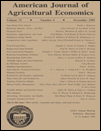Animal Stocking under Conditions of Declining Forage Nutrients
Abstract
This paper examines the bioeconomic conditions under which the recently popular intensive-early-stocking (IES) strategy outperforms the conventional season-long-stocking (SLS) strategy as a response to the deterioration of forage nutrients over the latter stages of the grazing season. The economic performances of the IES and SLS strategies are compared to a dynamically optimal grazing policy that continually fine tunes stocking rates to account for declining forage nutrients. The comparisons yield a range of qualitative properties under which the IES strategy tends to approximate better the optimal strategy, some of which are investigated in a numerical illustration.




